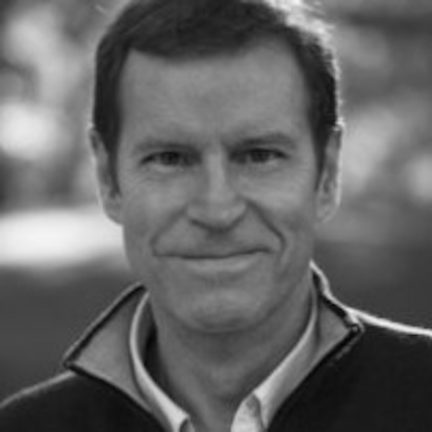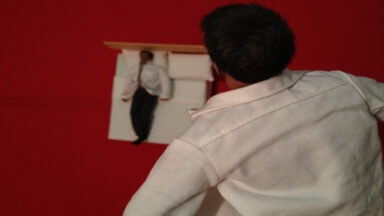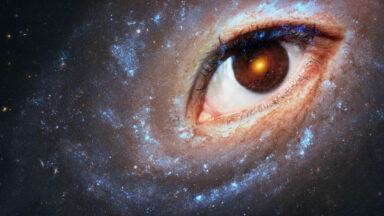What is Infinite Consciousness?

Have you ever stood on the edge of the Grand Canyon, or gazed into the heavens by a calm lake on a moonless night? Did you feel your self expand into that vast unimaginable vacuum, while at the very same instant you felt yourself collapse inward into your singleness, your simple insignificance? Is that a trick question? Maybe it only seems a little tricky because the answers to these crazy huge mysteries don’t just lie out there in the infinite universal consciousness, but also right in here, within the [not-so-finite] form that we call our Self.
The nature of everything we see, and everything we are, is defined and determined for us solely by our own consciousness. Yet everywhere we look there’s clearly more and more “outside” consciousness entering the world we can see, all of the time. Add to that its seemingly inexhaustible potential in many of the forms of the world that our limited perceptions won’t let us see, directly. And what of the possible consciousness alive in worlds beyond our own? Without even a good definition of consciousness to work with, how can we expect to comprehend its real range and reach?
“Science cannot solve the ultimate mystery of nature. And that is because, in the last analysis, we are a part of the mystery that we are trying to solve.” ::Max Planck
The Range and Reach of the Universal Consciousness Quandary
As unique, autonomous human beings, none of us can really wrap our heads around the vastness of space and what forms of intelligence may exist out there, but when the Kepler space telescope keeps finding thousands of earth-like planets, the sheer potential for conscious intelligent life is staggering. Likewise, we’re never particularly aware that deep within us there are endless tiny organisms constantly going about the moment-to-moment choices we all make to stay secure, find nourishment, have sex, and possibly discover some sense of purpose and fulfillment.
Whether we’re looking out into the cosmos, or into the sub-atomic constructs of the natural world, our power to discern the range and influence of consciousness is a direct result of how deeply our tools of observation allow us to penetrate. As our telescopes and microscopes improve, and our theorizing based on those observations becomes more complex and comprehensive, we find ever more structures of apparent consciousness in every direction we look. It seems that, endlessly, either we are projecting our own consciousness into our expanding reality, or that we find it there waiting for us already.
Universal Consciousness Definition
The simplest explanation appears to be this: Consciousness is an infinite energy field that creates the conditions to manifest different realities according to differing sensory perception. In this sense, consciousness is a pre-existing, universal presence, and fundamental element of both mind and matter—an ancient concept, known as panpsychism. As we have no means of demonstrating the emergence of consciousness from matter, we can only assume that it’s been there all along, and that everywhere we look we see matter expressing consciousness.
And in any direction that we investigate deeply, we discover the forms of the observable world manifesting themselves in series of reliably recurring patterns. Basic building-blocks — not just of of everything we can see, but of everything we can’t see, as well. There appears to be a design standard that suggests a seamless conscious intelligence—whether you believe it’s God, all a big coincidence, or just none of your business. They are the limitless variations on the forms of what is.
All the forms of our material reality realize themselves through a kind of spacetime ”sacred geometry” (as described in David Wilcock’s “Wisdom Teachings”). Constructs like the merkaba and torus, and fractal, holographic emanations exist at every scale manifesting in myriad ways as crystalline structures, force fields of electro-magnetism or gravity; or in constellating structures as in atoms and molecules, stellar systems, galaxies, and more. It’s not at all coincidental that the neurons and synapses in our brains resemble the cosmological patterns of the universe, and the connective web-like extrapolations of the internet (whose exponential growth indicates a kind of infinitely expansive consciousness in itself).
Proponents of the ‘consciousness as an existing infinite field,’ like Dr. Stuart Hameroff of the University of Arizona and Sir Roger Penrose (David Hawking’s former teacher, and his co-discoverer of the black hole/singularity theory) theorize a molecular structure describing the entanglement of everything in our material reality within a vast quantum plenum called the Planck Field. A field energized by consciousness—and, in a way, a modern avenue to our old idea of panpsychism.
The Old Way of Thinking About Consciousness is New Again
From Plato’s metaphysical concept of the universe, where eternal, indestructible forms—imperceivable forms beyond space and time—constitute the foundation of everything we are and can witness; to what the Buddha referred to as Alaya, or “storehouse consciousness” when he discussed the forms of consciousness; to when Dr. Carl Jung theorized his “collective unconscious,” and stated: “It is the matrix of all conscious psychic occurrences,” perhaps nothing describes the field of infinite consciousness like Hinduism, the oldest of the world’s enduring major religions.
“I pervade the entire universe in my unmanifested form. All creatures find their existence in me, but I am not limited by them…They move in me as the winds move in every direction in space.” ::The Bhagavad Gita 9:4‑6
While Buddhism is based on a spiritual evolutionary continuum revealed in levels of consciousness, Hinduism (the philosophical parent of the Buddha) comprehensively addresses the range and reach of consciousness itself. Sanskrit cultures describe an all-encompassing field that underlies everything, and becomes everything, called Akasha. From this, all the manifesting attributes of our universe realize themselves through the eternal state of Brahman—the infinite, undifferentiated, creative dynamic that serves as the seat of all consciousness.
To put it in a Western layman’s terms (like mine), Brahman is what we may be compelled to call “The Mind of God.” The grounding intelligence that permeates and manifests everything we can know (an idea I discussed in an earlier article, Is God Consciousness…or Vice Versa). Each of us is connected to Brahman through Atman, our personal soul, or self. Atman is our own consciousness, which we struggle to expand in order to see beyond the illusory forms of the material world (called Maya) towards our realization of the infinite.
Pretty progressive stuff for being so old, don’t you think?
So What Does Infinite Universal Consciousness Mean for Me?
So here we are, where the observer, the observed, and the whole darn process opens up within our shared field of infinite consciousness, dependent upon our conscious awareness of it—which is where the personal meaning comes in for each of us in terms of our direct experience.
“Consciousness is that in which all experience occurs; is that with which all experience is known; is that out of which all experience is made.” ::Rupert Spira
Many of us have had breakthroughs in our lives, radical transformations resulting from the expansion of our consciousness (atman) into our infinite potential. These often result as a product of trauma, loss, great fortune, or the presence of a remarkable teacher, or life-lessons where our concept of self was destroyed, then recreated.
Suddenly, we’re granted greater access to an extra-dimensional aquifer, where our conscious awareness no longer thinks of itself as coming from anywhere. Where we realize that each of our finite minds originates from the same infinite field of consciousness.
Then we can sense our entanglement, our inter-connectedness with everything, and behave accordingly. Responsibly. We recognize that in living an “infinite life” (thank you, Robert Thurman), our obstacles are old foes and our possibilities are limitless. We begin to recognize that a kind of divine guidance and intuitive intelligence is built—in patterns—into our lives on this level of consciousness.
The evidence of infinite consciousness is all around us, the moment you open up to it. Our capacity for experiencing the infinite is always available—without drugs or even gurus—but maybe with just a little serious practice of meditation. Meditation is the gateway to the infinite, and can lead to revelations of extra-dimensional consciousness in a similar way as described in the heavily documented experiences of near-death survivors, remote-viewers and psychics, and adult—and child—reincarnation subjects (like in the exhaustive research by the University of Virginia’s Department of Perceptual Studies). The realm of infinite consciousness is the realm of transpersonal experience, as well as the realm of the afterlife—of infinite life.
Personally, the evidence of infinite consciousness is available the moment you become willing to deeply investigate the moment. For example, look inside your eyelids—what do you see? You see the actions of your eyes in the absence of light. But something else, too—faint, effervescent waves in a sea of infinite energy issuing directly from our shared source of intelligent awareness. Then you may look into the heavens on a starry night and find that you can’t really focus on that either—but you can sense your spiritual expansion into the limitless grandeur of the cosmos. Anything, everything is possible out there…and everything is possible in here.
“Our deepest fear is not that we are inadequate. Our deepest fear is that we are powerful beyond measure…Your playing small does not serve the world.” ::Marianne Williamson
Almost all the bad things in the world happen as a result of people living constrained by the lonely sense of their singular consciousness. Fearful self-centeredness makes them feel as though they were pitted against everyone else, and they do terrible things.
That is where evil comes from. When we realize and engage in our shared infinite consciousness, we discover that we need other people.
We intuitively act together for the benefit of everyone (and the earth), and good grows and spreads across humanity. People, and the planet, are healed.
The Cosmic Net of Reflection
I’ll leave you with this: The Hindu Vedas, by way of Mahayana Buddhism, give us the gift of the “Net of Indra” (the god of the heaven) — a beautiful metaphoric concept of our relationship to the infinite field of consciousness.
The Net of Indra stretches out in infinite directions, and is comprised of many-faceted jewels, each suspended so that all of its facets reflect all of the other jewels in the endless cosmic net.
In much the same way, we are all joined together in this web of being — all reflecting one another, and the miraculous light that illuminates us and everything we witness in our universe. Delicate. Eternal. Alive.
What Are the Akashic Records and What Are They For?

The Akashic Records are the energetic archives where the information of every soul is recorded. Everything that has been said, done, and even thought leaves an imprint on this energetic field. What is most astonishing is that we all have the ability to connect with this impressive library of the soul to discover guidance, wisdom, and a deeper understanding of our existence. In this article, we will explore what the Akashic Records are, how to access them, what benefits they can offer, and what is needed to begin this spiritual path.
Table of Contents
- What Are the Akashic Records and What Are They For?
- What Is an Akashic Records Reading Like?
- What Kind of Questions Are Asked in an Akashic Reading?
- Is There Any Danger in Accessing the Akashic Records?
- Who Can Read the Akashic Records?
- How Do You Learn to Read the Akashic Records?
- History and Origin of the Akashic Records
What Are the Akashic Records and What Are They For?
The Akashic Records are a universal memory of existence, an immaterial space where every event, statement, thought, or action is recorded. This archive of the soul not only preserves the history of each individual life and its interpersonal connections, but also captures universal dynamics, providing a complete perspective on the soul’s journey and its evolution through time.
This energetic dimension is accessible through specific meditation techniques and can be consulted to obtain spiritual guidance, healing, and understanding of behavioral patterns and karmic relationships.
In addition to its role as a source of spiritual knowledge, the Akashic Records are used to facilitate personal and collective healing. By accessing this wisdom, people can explore a wide range of topics—from emotional and physical challenges to existential questions—discovering not only the roots of their difficulties but also paths toward deep transformation and significant spiritual growth.
In the series Microdose, available on Gaia, the fascinating subject of the Akashic Records is explored, offering an accessible and practical perspective for those who wish to deepen their understanding and use of them.
What Is an Akashic Records Reading Like?
An Akashic Records reading is an intimate encounter in which a trained reader accesses this energetic dimension to transmit to the seeker the messages that emerge from there. Traditionally, readings were conducted in person, but in recent years, online Akashic Records readings have become increasingly popular, as well as written versions.
The session is carried out through guided meditation and the use of specific prayers, allowing the reader to reach a deep state of concentration and connection to access the seeker’s records. During this process, the reader uses their sensitivity and training to perceive and convey the visions and messages received.
A typical session is structured as follows:
- Session Preparation: Before beginning, the reader and seeker prepare the space, often creating a peaceful and respectful environment, free from interruptions.
- Opening Invocation: The reader uses a specific prayer to open the seeker’s records, requesting permission to access and reveal the necessary information.
- Reception of Information: While in a meditative state, the reader receives images, words, emotions, or even physical sensations that are relevant to the seeker’s inquiries.
- Dialogue and Clarification: As the information flows, the seeker may ask additional questions, and the reader helps interpret the messages received, ensuring clarity and understanding.
- Closing the Records: At the end of the session, the reader performs another prayer to formally close the records, ensuring that the spiritual connection is properly closed.
What Kind of Questions Are Asked in an Akashic Reading?
The questions for an Akashic Records reading can be as varied and profound as the concerns of the seeker. Ideally, the questions should be open-ended and oriented toward guidance and personal growth, avoiding those that require simple yes or no answers.
Here are some common questions that can be asked during a reading:
- What is my purpose in this life?
- What lessons do I need to learn from my past experiences?
- How can I improve my relationships with family and friends?
- Are there any energetic blockages that are preventing me from moving forward?
- How can I use my talents to serve others?
- What can I do to improve my financial situation?
- How can I achieve greater balance in my life?
- What do I need to release in order to heal emotionally?
- Are there any messages from my spirit guides or deceased loved ones?
- How can I prepare for the important changes that are coming into my life?
Is There Any Danger in Accessing the Akashic Records?
Accessing the Akashic Records is a safe practice. Nevertheless, it is common for questions to arise about the potential dangers of the Akashic Records, especially among those who are new to this path. This spiritual practice is based on the opening of a sacred and protected space through specific prayers and meditations that ensure a pure and clear connection with the source of all Akashic wisdom. The process of access is guided by the intention of benevolence and respect for universal wisdom, which ensures that only the information that serves the highest good of the person involved is revealed.
In addition, the guardians of the Akashic Records—beings of light and ascended masters—are always present to ensure that the interactions are for the growth and benefit of the seeker. Therefore, as long as the person approaches the records with respect, humility, and an open mind, there is no risk of adverse effects. On the contrary, access to the Akashic Records can provide a profound understanding that fosters personal and spiritual growth, freeing the individual from old attachments and facilitating a clearer path forward.
Who Can Read the Akashic Records?
Although reading the Akashic Records may seem like a domain reserved for psychics and mediums, in reality, it is within the reach of anyone who wishes to deepen their spiritual understanding. It is not necessary to be a natural clairvoyant or possess special paranormal abilities; with proper preparation and the right intention, anyone can learn to access their own records or even those of others, as long as it is done with respect and responsibility.
The ability to read the Akashic Records is not limited to a chosen few, but rather, it is a skill that can be developed through practice and study. Many spiritual schools and teachers offer courses and workshops that guide aspirants through the process of opening their own records, as well as techniques to interpret the information received in an ethical and compassionate manner. This openness democratizes access to Akashic knowledge, allowing each individual to explore their spiritual heritage and contribute to their personal evolution.
How Do You Learn to Read the Akashic Records?
Many practitioners begin their learning by attending workshops and courses offered by experts, who teach access techniques, opening and closing prayers, and methods for interpreting the information received. These courses also emphasize the importance of ethics and responsibility when reading the records of others.
In addition to in-person courses, there are numerous online resources, such as books, videos, and webinars, that provide detailed instructions on how to access and read the Akashic Records. Ongoing practice is essential, as each reading session helps refine the ability to perceive and communicate the subtle energies and information of the Akashic field. Many readers experience significant growth in their personal and spiritual understanding as they continue working with the records.
History and Origin of the Akashic Records
The Akashic Records, as understood in the modern context, were first brought to prominence by Helena Blavatsky, founder of the Theosophical movement in the late 19th century. Blavatsky introduced the concept to the West after her studies and experiences in Tibet, where monks and mahatmas revealed to her that the records exist in the “akasha” or “akasa”—a Sanskrit word meaning astral light or the ether, the fifth element in Eastern belief systems, considered the fundamental fabric of reality.
Blavatsky, supported by what she called “Masters of Ancient Wisdom,” used her psychic abilities and astral projection to access these records. This knowledge allowed her to establish a theosophical foundation that proclaimed “there is no religion higher than truth.” Her teachings and revelations attracted many followers and helped solidify the idea that human actions, words, and thoughts leave lasting impressions on the etheric plane, influencing Western esoteric doctrine.
Rudolf Steiner, another influential metaphysician, also spoke about the Akashic Records, proposing that every human action and thought leaves a trace in the etheric realms. Steiner contributed to the conceptualization of the Records as a compendium that not only stores past events but also offers patterns for human ideals such as harmony and equity, influencing contemporary thought and applications in the field of human evolution.
Edgar Cayce, known as America’s “sleeping prophet,” further popularized the Akashic Records during the 20th century through his psychic readings. Cayce described in detail how each individual could access the records of their past, present, and future lives to facilitate healing and personal growth. According to Cayce, these records not only document every life but are also fundamental to the soul’s judgment process—an idea that resonated with the biblical notion of the Book of Life.
Contemporary exploration of the Akashic Records has been advanced by theorists such as Ervin Laszlo, who integrates the notion of Akasha with scientific theories to explain phenomena such as consciousness and synchronicity in his “Akashic Paradigm.” Laszlo and other researchers continue to explore how the universal memory of the Akasha can serve as a living archive that influences the life and evolution of every being in the universe, proposing a holistic approach that crosses the boundaries between science and spirituality.





































